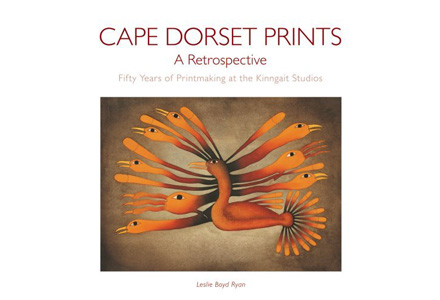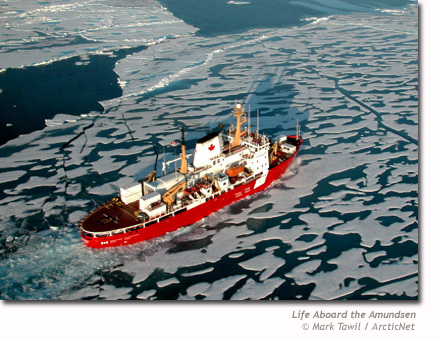by admin ~ November 5th, 2007

Paul Nicklen has previously been recognized for his outstanding photography in the Canadian Arctic, and was the recipient of two World Press photo honors. His essay on the return of Narwhals to their summer grounds around Baffin Island (and the hunting of Narwhals for food and ivory) appears in the August 2007 issue of the National Geographic Magazine. The web feature includes photos and fieldnotes in pursuit of this enigmatic and shy whale, whose spiraled tusk is still a mystery to scientists. For many Inuit, the return of the tusked whale is a important mainstay to their diet and northern livelihood. The photo “Breath Taking” won top honors in the Shell Wildlife Photographer of the Year exhibition for 2007.
More information:
Filed under: Climate Change, Exhibits, First Nations, Lands and Resources, Photography
Comments Off on More Accolades for Wildlife Photographer Paul Nicklen
by admin ~ November 1st, 2007
.jpg)
One chapter is closed . . . and more questions remain. After several months delay, and a cabinet reshuffle, the Department of Indian and Northern Affairs has finally given some direction to the rush for mineral exploration in the Northwest Territories on lands in the Upper Thelon River Basin. Ur-Energy Inc. (a junior mining company based in Colorado and Ontario) submitted a land use application for exploratory drilling on it’s Screech Lake claims twice in the last three years. The regulatory body mandated to evaluate the social and environmental impacts of new developments in the Northwest Territories held public hearings on the proposal and recommended against the development last May, 2007. The Review Board’s Report indicated a significant public concern for the project, and concluded while “the proposed development is physically small, the potential cultural impacts are not” (pg. 1). In a letter sent October 23, 2007, the Hon. Minister Stahl of the Department of Indian and Northern Affairs agreed with the Review Board, and rejected the land use permit “without environmental review.”
With four other developments looming in the region, and one company (Uravan Minerals Inc.) continuing to drill on it’s 2007-2008 permit, it is still unclear what the Federal decision means for the future of uranium claims in the region. In his approval letter, Minister Stahl tasked the Department to develop a plan “for addressing the broader long term context of land-use in the area”, which the CBC reports “may allow development in some areas of the basin.” A draft plan is scheduled to be shared with key stakeholders by the end of November. And in a response to the Federal decision, Ur-Energy Inc. President Bill Boberg indicated his company sees the decision as “a delay” (CBC), and “will continue to pursue any and all approaches that will allow us to properly explore the project as soon as possible” (Ur-Energy). It’s efforts to lobby the Federal government have been on-going.
Many continue to watch the issue with a high level of interest, and hope that any future policy decisions on land use planning and exploration proposals will continue to reflect current public values, and also a significant level of involvement from local constituencies and other parties directly impacted by mining developments in the region. The previous recommendations and report of the Review Board received a broad level of support from local First Nations, tribal organizations, eco-tourism operators, NGOs, wildlife managers, and the general public. With the public interest now underscored by Federal action, it is clear that many see closer consultation and stronger limits on mining activities in the Upper Thelon Basin as providing a major benefit to the Northwest Territories, the long term public interest, and the diverse constituencies of the North.
For more information:
Filed under: First Nations, Lands and Resources, Mining, Thelon River
Comments Off on Minister Accepts Review Board Recommendations and Denies Ur-Energy Exploration Permit In Thelon River Basin
by admin ~ October 18th, 2007

I just received the first issue of the newsletter from Parks Canada on the Nahanni Park Expansion (summer 2007). It contains pullouts on a Nahanni Dall Sheep Study, Grizzly Bear Research, Woodland Caribou Research, the North Karst, and Glacier Retreat Monitoring. It contains updates on the Deh Cho and Sahtu processes, protecting heritage and traditional lands of the Dene and Metis, and statistics on visitor spending, park expenses, and such. It’s interesting to note that many of key ranges and survey areas for the Dall Sheep study are directly in the vicinity of the proposed Prairie Creek mine development. It looks like a lot of detailed work and scientific justification for what many of us already know … the Nahanni watershed is unparalleled in its historical significance and natural beauty, and deserves full protection as a canoeing and heritage Park and ecosystem for future generations. The brochure (titled “Taking Care of Naha Dehé”) is the first newsletter of the proposed expansion of the Nahanni National Park Reserve. If you’d like to receive a copy, or be added to the list for future updates, you can write to:
Steve Catto, Park Establishment Officer
Nahanni National Park Reserve
P.O. Box 348
Fort Simpson, NT X0E 0N0
Phone: (867) 695-3151
E-mail: Nahanni.Expansion@pc.gc.ca
or
Anna Rowe, Communication and Consultation Officer
Parks Canada
P.O. Box 1166
Yellownife, NT X1A 2N8
Phone: (867) 766-8464
E-mail: Nahanni.Expansion@pc.gc.ca
For further information: CPAWS, Parks Canada, CBC, Canadian Heritage River Fact Sheet, Deh Cho First Nations Negotiations, Northern Currents, Mining Watch, Canadian Zinc Corporation (Prairie Creek).
Filed under: Books, Canoeing, First Nations, Lands and Resources, Nahanni River, Parks
Comments Off on Parks Canada Newsletter: “Taking Care of Naha Dehé” (the South Nahanni River Watershed)
by admin ~ October 16th, 2007

Kinngait Studios (the graphics program of the West Baffin Eskimo Co-operative) is a printmaking co-operative that has provided 50 years of support to independent community artists in the North, and was influential in reshaping community development approaches in Nunavut and beyond. “Cape Dorset Prints: A Retrospective” examines the 50 year history of this dynamic Inuit institution in over 200 color prints, and thirteen essays by artists, historians, and Co-op founders. The release of the book by Pomegranate Press is set to coincide with the annual 2007 Cape Dorset Print Collection, and exhibits in Toronto and the Nunatta Sunakkutaangit Museum in Iqualiut. More below:
Sources:
Filed under: Books, Events, Exhibits, First Nations, Graphic Arts, Life and Culture
Comments Off on Book Launch: 50 Years of Printmaking at Cape Dorset
by admin ~ October 15th, 2007

The expedition is a third of it’s kind, and will retrace historic voyageur routes in Ontario and the Prairies in a 26-foot replica birchbark canoe. The web site features extensive information on previous expeditions: member biographies, photo galleries, videos, press release, journals. Here is the full announcement:
Métis Canoe Expedition Seeking Young Adventurers
In 2003 the Métis Canoe Expedition, a youth project sponsored by the Métis Nation of Ontario in partnership with Fort William Historical Park, re-traced the 2,000+ kms historical canoe route used by the Voyageurs 200 years ago. The crew of 10 Métis youth participants and an experienced expedition leader paddled a 26-foot replica birch bark canoe ten to twelve hours a day during the two-month trek following the Ottawa and Nipissing Rivers to Lake Huron and Lake Superior from Lachine, Quebec to Old Fort William in Thunder Bay. In 2005 the Second Métis Canoe Expedition continued on deep into the Northwest from Thunder Bay to Batoche, Saskatchewan a journey of nearly 2,300 kms. The Métis Nation of Ontario is looking for interested Metis individuals to participate in the Third Métis Canoe Expedition. This year’s expedition will a unique life experience. This adventure of a lifetime will take place between May and August, 2008. Two weeks of training will be arranged, but applicants are encouraged to be in good physical condition. Applicants must submit the following: 1. A current resume 2. Three (3) references 3. Registration Form 4. Métis verification form 5. Medical form 6. An essay (max 500 words) describing why you want to be a part of this project and why you should be selected for the expedition. Please include details regarding your their involvement with the MNO or the Métis Community, your leadership experience and any other qualifications or information you feel are relevant. The Métis Canoe Expedition connects Métis youth with Métis culture and heritage while immersing them in the outdoors. These journeys demonstrate the courage and integrity of Métis youth and what they are capable of accomplishing. They create youth leaders and role models who embody the strength and pride of the Métis Nation.
CONTACT: Chelsey Quirk, Communications Assistant Work: 613-798-1488 Ext. 104 Cell: 613-299-6085.
Filed under: Events, Expeditions, First Nations, Life and Culture
5 Comments »
by admin ~ September 8th, 2007
.jpg)
Uravan Minerals Inc. (“Uravan”) and Cameco Corporation (“Cameco”) continue uranium exploration activities in the Thelon Basin this summer with a total of four diamond drill holes completed, and three more scheduled. Their current land use permit covers the 2007-2008 season, and they seek to extend their permit to cover a larger area of the Boomerang Claim south of the Thelon Game Sanctuary with two additional land use applications. Uravan notes the approval process for additional drilling on their Boomerang Claims has become much more difficult since a Mackenzie Valley Environmental Impact Review Board finding in 2007, which noted significant “public concern” for uranium exploration proposals in the upper Thelon River Basin and recommended against approving an exploratory drilling program at nearby Screech Lake (see MVEIRB public registry and final report). Two new land use proposals have been submitted by Uravan (EA0708-002 and EA0708-003), and they estimate the review process could take 9 to 12 months to complete. Bayswater Uranium Corporation has also submitted two proposals for exploratory mining projects (EA0708-004 and EA0708-005 ) on nearby lands in the Upper Thelon River Basin.
Sources:
Filed under: First Nations, Lands and Resources, Mining, Thelon River
Comments Off on Four New Environmental Reviews Proposed for Mineral Claims on the Upper Thelon River Basin
by admin ~ May 11th, 2007

The Mackenzie Valley Environmental Review Board has reviewed the request of Ur-Energy for a Land Use Permit on an exploratory drilling program at Screech Lake in the Thelon Basin, NWT, and has recommended that the project not be approved. It is only the second time that the Review Board has not recommended a project.
As reported in January, Ur-Energy initiated its second environmental assessment process in two years, the first (EA 0506-003) being abandoned by the company after strong community concerns at Lustel K’e and cost overruns projected by the company. The Review Board agreed to the second request (EA 0607-003), and held public hearings and reviewed written submissions in January to evaluate the environmental and cultural impact of the uranium exploration project. Its final report was released on May 07, 2007 (and can be download here). It acknowledges the unique cultural and ecological values of the Thelon River and Basin, and cites the spiritual significance of the area to Dene First Nations, wilderness values, economic disruption to ecotourism businesses, and the lack of a land use plan as primary concerns. In its own words: “The Review Board is of the view that although the proposed development is physically small, the potential cultural impacts are not” (pg. 1).
The report now gets forwarded to the Minister of Indian and Northern Affairs for a final decision. Ur-energy indicates it intends to meet with the Minister and “will continue to pursue any and all approaches that will allow us to advance exploration on the project as soon as possible.” Urgent action is needed. Please write a letter to the current Minister of Indian Affairs and Northern Development, the Honourable Chuck Strahl, urging him to accept the recommendations of the of the Review Board.
Hon. Chuck Strahl
Minister of Indian and Northern Affairs Canada
2100-10 Wellington Street
Ottawa, ON K1A 0H4
minister@inac.gc.ca
(819) 997 0002
RE: EA 0607-003 (Mackenzie Valley Environmental Impact Review Board Report of Environmental Assessment and Reasons for Decision On Ur Energy Inc. Screech Lake Uranium Exploration Project).
Additional Information:
Filed under: Canoeing, First Nations, Lands and Resources, Mining, Thelon River
2 Comments »
by admin ~ May 8th, 2007

Mobile field station (NOMAD) combines social science and natural sciences to explore human-Rangifer interactions in the Kola Peninsula of the Russian Federation and the Murmansk Region of Samiland. Research seeks a comprehensive understanding of the changing environment, climate change, and resource use of domestic reindeer herding. Researchers will follow the herds for up to a year (March 2007-Februrary 2008), and document socio-economic adaptation to environmental processes and changing seasonal rhythms: “state of the herd and grazing range; response and resilience of reindeer-dependent communities, etc. — corresponding coping strategies, and changing modes of resource management” (1). Central to NOMAD is the development of ethnographic research methods to document migratory human and animal interactions (state-farm cooperatives and activities, market forces, mechanisms of management and control, interaction with tourism, and impact of changing climate) and to overcome shortcomings of fixed field studies that focus on local specifics. NOMAD is a featured project of the International Polar Year, and provides educational outreach to media, teachers and researchers through its website and blog.
Update:
Filed under: Anthropology, Climate Change, Lands and Resources, Life and Culture
Comments Off on NOMAD and Long Term Monitoring of Migratory Reindeer Herds in Northern Samiland
by admin ~ May 2nd, 2007

Innovation Canada is an on-line web magazine featuring new research in Canada, and projects funded by the Canadian Foundation for Innovation. Since its creation in 1997, the Canada Foundation for Innovation (CFI) has committed up to $3.7 billion in funds to 5,000 projects at more than 125 universities, colleges, research hospitals, and non-profit research institutions across Canada. The current issue highlights research in the Canadian North, and CFI projects linked to the International Polar Year. Various essays profile educational programs, International Polar Year funding, paleoclimate research, information sharing, youth initiatives for raising awareness on environmental matters, and more. Guest author Susan Aglukark writes about her home community of Arviat, Nunavut, and concerns over pollution, water quality, and wildlife habitat at an estuary near the community. These stories and more are available in Issue #27. The archive of previous issues are available here.
Filed under: Climate Change
1 Comment »
by admin ~ April 26th, 2007

The spring polar expedition round-up adds another milestone to the list. As reported in Far North Science and the Arctic Arc expedition website, two Belgium explorers (Alain Hubert and Dixie Dansercoer) reach the North Pole after 578 miles and 54 days of travel from the north coast of Siberia. They now depart on the last and final leg of their journey, and will travel 2100 miles to reach the southernmost tip of Greenland by June. In total, they will have traveled an astounding 4,300 kilometers (2,700 miles) in one season. The expedition is connected to the International Polar Foundation, and looks to measure snow depths, and record how global warming and climate change are effecting the lives of people, animals, and ice in the North. Eight expeditions are linked to the Polar Foundation’s website:
- The Arctic Arc: To celebrate the International Polar year 2007-2008, Alain Hubert and Dixie Dansercoer will attempt a traverse from Siberia to Greenland on skis.
- Tara Arctic: The French schooner, Tara, has been assigned a great polar challenge: to drift on the Arctic pack ice for two years, starting September 2006, and while so doing, celebrate the IPY (International Polar Year).
- Total Pole Airship: Jean-Louis Etienne is getting ready for a new adventure. After his expedition to Clipperton with the aim of drawing up a report on the state of nature of this unknown atoll, the renowned French explorer returns to the North Pole.
- Wide Arctic: Wide Arctic is a travel on the east coast of Baffin Island, in northern Canada. This trek serves to support an educational program aiming to introduce children aged 10 to 12 to global warming and sustainable development.
- North Pole Quest: Richard Weber, Iain Morpeth and Adrian Hayes are attempting the trek Ward Hunt – geographical North Pole, with one resupply (march until end of April).
- Arctic Ocean 2007: Famous female explorers Ann Bancroft and Liv Arnesen are on the move again. This time, they will attempt an unsupported trek from Ward Hunt to the North Pole.
- Mars North Pole Solo: In March 2007, British female explorer Rosie Stancer will fly to Ward Hunt Island on the northern tip of Canada and set off on her epic journey across the frozen Arctic Ocean. She wants to be the first woman in the world to walk solo to the North Pole.
- Global Warming 101 Expedition: Educators and explorers Will Steger, John Stetson, Elizabeth Andre and Abby Fenton will join four Inuit hunters on a 1200-mile,four-month-long dogsled expedition across the Canadian Arctic’s Baffin Island.
Filed under: Expeditions
Comments Off on Two Belgium Explorers Reach North Pole Milestone

.jpg)



.jpg)




.jpg)